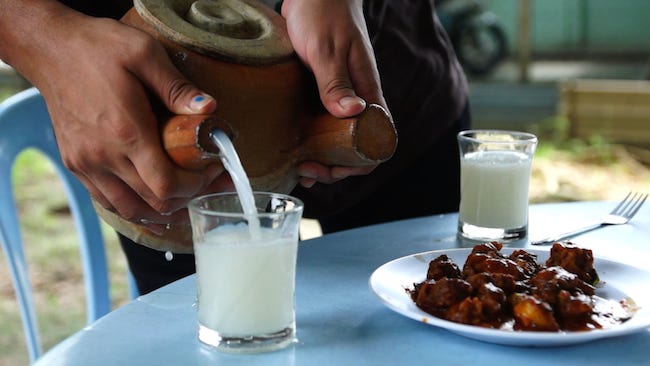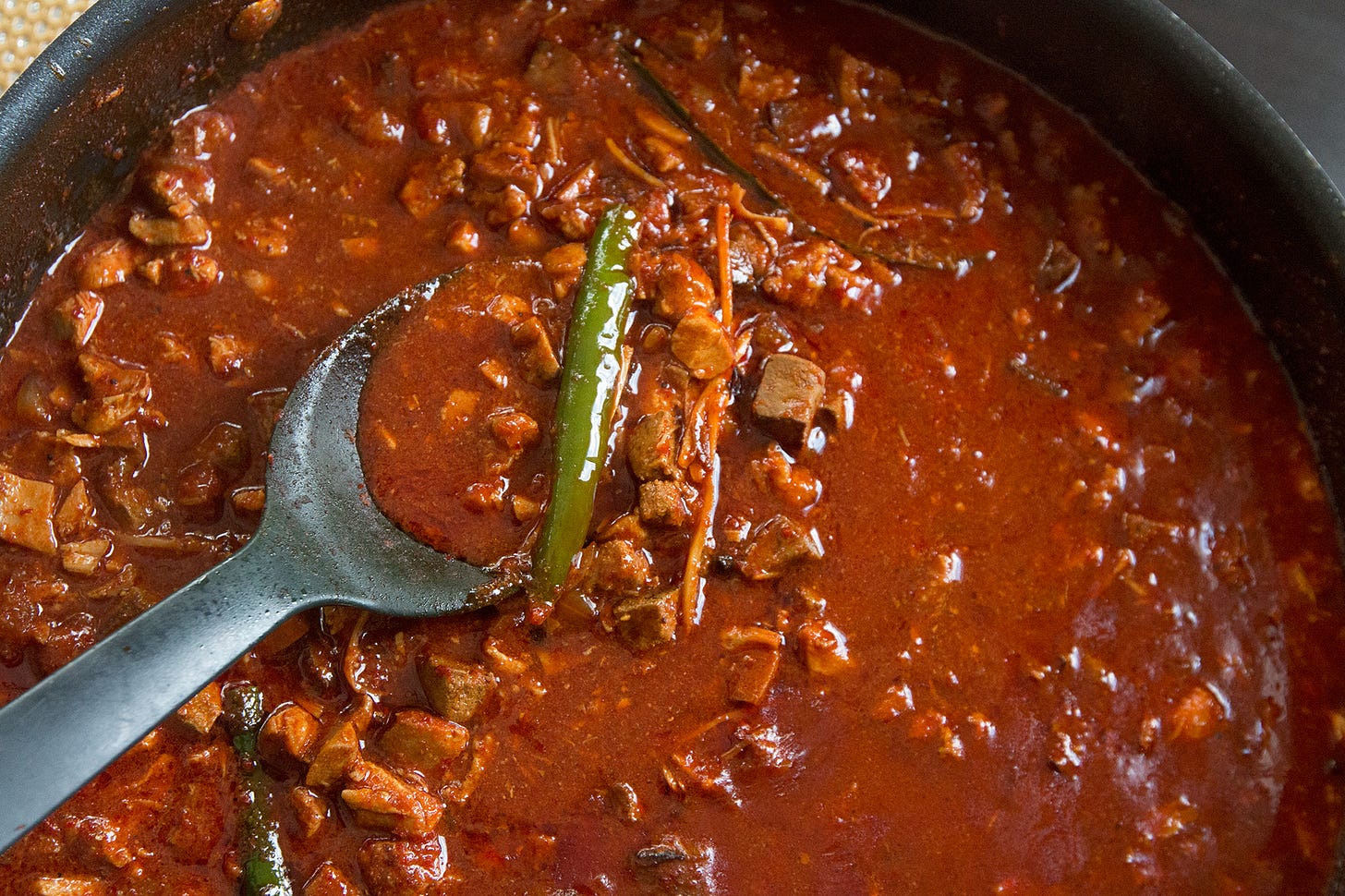Feng is a dish that I’ve hesitated to make for a long time, solely because of the way it looks. Based on what I’ve seen online, it is murky brown and, in some versions, dry and almost paste-like in consistency. But then, earlier in the year, the passing of Chef Floyd Cardoz compelled me to revisit some of his older Instagram story highlights, and I came across his process for Goan sorpotel. His version looked really good, and so I made it one night, riffing off the dish with the smoked pork hock and canned beans that I had on hand and it was absolutely delicious. That really sparked the curiosity in me to want to make feng, to taste how different the two dishes are.
The use of offal
It is said that sorpotel is the precursor to feng, which isn’t a surprise given the parallels between these two Portuguese-influenced dishes. A common origin story told is that during the first Portuguese sea explorations to Asia, pigs onboard the ship would be slaughtered. Because of the scarcity of food, no part of the animal was wasted and even what were considered to be off-cuts had to be eaten. Others say that this offal stew has an even further-reaching history, tracing it to Brazil (a Portuguese colony), where African slaves cobbled together scraps of meat and offal from their masters.
When the Portuguese intermarried with the locals, a fusion cuisine resulted. The locals started adding spices to this stew, resulting in unique spinoffs - Goan sorpotel and Eurasian feng.
Due to this backstory, despite its celebratory character, feng is said to be a poor man’s dish. Wex, not knowing about any of this, expressed surprise at the Eurasians having such a humble dish in their festive repertoire and that he cannot imagine a wealthy European wanting to eat offal stew for Christmas. Unfortunately, where I live, offal is hard to come by (they usually feed it to the dogs), so I stuck to just pork belly.
Frying the meat & offal
Sorpotel and feng begins by simmering the offal/ meat until it is cooked. Simmering the meat in water not only sets it sufficiently to be cut into cubes, but also results in a quick stock. I was reminded of sambal goreng pengantin as I was preparing this, where meat and offal are similarly cooked, then cubed and stewed.
In sambal goreng pengantin, the cubes of meat are deep-fried before being stewed for an extra depth of flavour. There is a similar step in Goan sorpotel but lacking in Eurasian feng (or maybe it is tradition that has been lost along the way) where the meat/ offal is fried in its own fat. As the meat fries, its fat renders and it browns, creating such a depth of flavour and richness.
Because I was more keen on making the tastiest feng rather than the most traditional feng, I went ahead and did this step. And I don’t regret it! I couldn’t stop snacking on the fried pork cubes.
Putting the stew together
Chopped onions and rempah are then fried in the rendered fat from frying the meat, before the fried meat, stock, and feng curry powder is added. If you live in Singapore, you can get your local spiceman from the wet markets to blend some feng curry powder for you. Jeya Spices also sells his own version. I didn’t want my feng to be too paste-like; at home, we always love more gravy to pour over rice. I made it looser, more sorpotel-style, thickened enough to cling to the meat.
Adding vinegar & mustard
And now, we season with vinegar. This is what makes Goan/ Eurasian cuisine so special! See, when the Portuguese came to Asia, they brought with them a love of pork and wine vinegar. But, a tropical climate was not conducive to growing grapes and producing wine or European-style wine vinegar. The Portuguese and Goans improvised by fermenting toddy, the sap from palm tree flowers, into alcoholic coconut toddy, and using it in place of vinegar.

While toddy is unavailable in Singapore today, toddy-drinking used to be a habit of Tamil coolies in Singapore’s rubber estates. It was an affordable pleasure, and one which diminished as Singapore developed economically. With complaints of drunken coolies, problems of tampered toddy, and conflicts between tappers and toddy contractors arose, a nationwide ban on the beverage was imposed. Today, regular vinegar is used instead in Eurasian households.
Vinegar serves two functions - it cut the richness of the stew, and also acts as a preservative. Because of this, the stew was especially popular with Portuguese sailors travelling between Lisbon and Asia.
A few recipes for feng also call for English mustard, which also features in other Eurasian dishes such as Devil’s curry - this is probably due to the influence of the British. I’ve chosen to leave English mustard out in my feng because I’ve tasted it and prefer it without.
Aging
Many recipes for feng and sorpotel call for a resting phase. Some call for at least an overnight’s rest. Some say that the dish needs to sit for a few days in a ceramic pot for the flavours to marry. While the labour explains why both dishes are made only on special occasions, the fact that they get better with age echoes the very essence of Christmastime - when dishes are made to last, so that people have the free time to visit loved ones, while always having a delicious dish on the table when the occasion demands.

Taste
When I ran a poll on Instagram, 85% of respondents said that they’ve never tasted feng before, so I thought I’d share more about how it tastes and what to expect. I really get why people call it a curry more than a stew - it tastes like one! It brought to mind curry puff filling, just that you get a really lovely tang from the vinegar that cuts through the richness of the pork fat. It was also very texturally interesting - the pork belly is not cooked for a long time, so you get quite a firm bite from the meat, chewy skin, and soft fat. But because it is cut into cubes, it doesn’t come across as dry or tough.
There is no chillies or chilli powder in many of the feng recipes I looked at, but I can’t do without chilli so I’ve added some as a garnish! I can see this being prepared in a big batch and used as a springboard for so many other dishes - tacos, curry puffs, toasties (we did this for breakfast this morning!)… it freezes really well. Wex thought it was feng-tastic (I’ve had to put up with so many bad puns yesterday hahaha)!
Merry Christmas to all celebrating! I will send one last newsletter for the year next week but till then, here’s wishing you a very wonderful time spent with loved ones and good food 🧡
Feng
Serves 4-6










